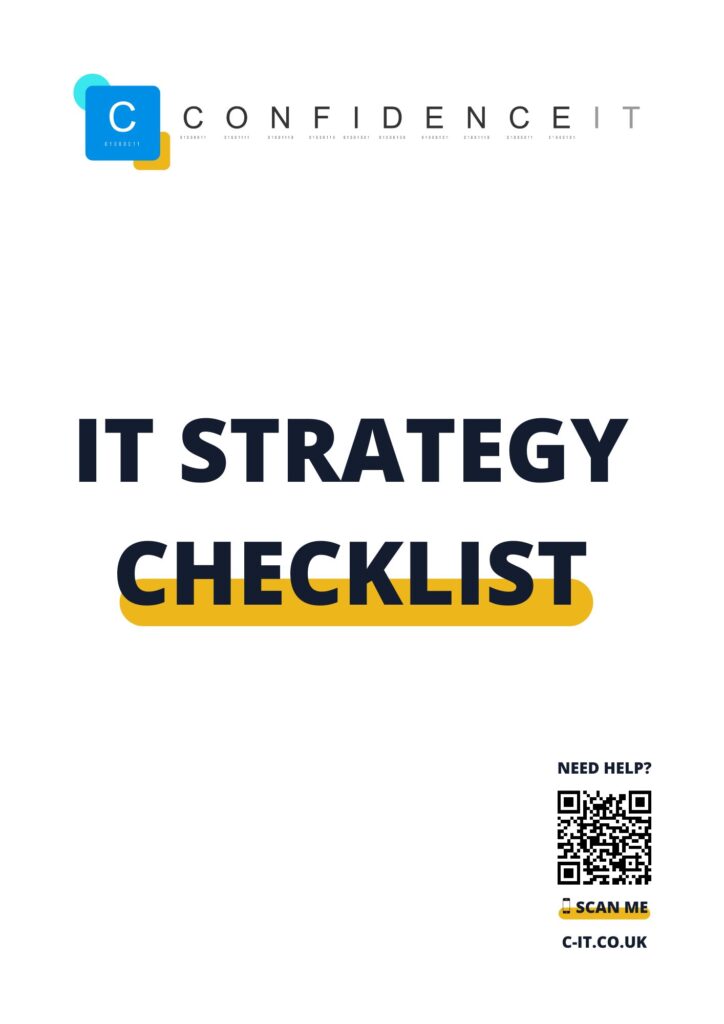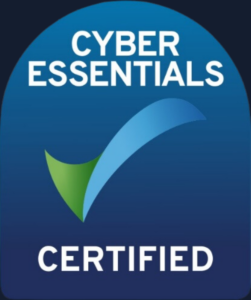Improve your
IT Strategy

What’s the plan?
WHY DO YOU
NEED AN
IT STRATEGY?
In today’s technology-driven world, an effective IT strategy is crucial for businesses aiming to enhance operations, stay competitive, and drive innovation.
Whether you’re a small startup or an established enterprise, this checklist is designed to guide you through the essential steps of improving your IT infrastructure, aligning technology with business goals, and maximising the value of your IT investments.
By systematically addressing each item on this checklist, you’ll be able to strengthen cybersecurity, optimise your IT infrastructure, foster collaboration, and ensure that your IT initiatives are closely aligned with the needs of your business.
Prepare to transform your IT landscape and pave the way for business growth and success!
12 Key Points
Define Business Goals
Articulating clear business goals is essential for developing an effective IT strategy. Identify your organisation’s objectives, such as market expansion, improved efficiency, or customer satisfaction. By aligning technology initiatives with these goals, you ensure that your IT strategy supports and drives business success. Regularly reassess and update goals to stay aligned with the evolving market landscape.
Assess CURRENT STATE
Evaluate your existing IT infrastructure, systems, and processes to identify areas for improvement. Assess hardware, software, and networking components for performance, scalability, and reliability—Analyse systems and applications for inefficiencies or gaps.
Streamline workflows and automate processes where possible. Evaluate the skills and capacity of your IT team. Consider compliance requirements, industry trends, and emerging technologies. Use this assessment to prioritise and allocate resources effectively for a targeted IT strategy.
IT GOVERNANCE FRAMEWORK
Create a clear IT governance framework to guide decision-making and ensure alignment with business objectives. Define roles, responsibilities, and decision authority. Establish processes for project prioritisation, resource allocation, and risk management. Adhere to regulations and compliance standards. Implement reporting and monitoring mechanisms. This framework promotes strategic decision-making, accountability, and successful IT strategy implementation.
DEVELOP A TECHNOLOGY ROADMAP
Create a roadmap to prioritise and implement technology projects aligned with business goals. Consider industry trends and potential benefits. Set timelines, allocate resources, and track progress. Update the roadmap regularly to adapt to changing needs and advancements. This ensures a strategic approach to technology adoption and supports business objectives.
ENHANCE CYBERSECURITY MEASURES
Strengthen cybersecurity to safeguard your organisation’s data and systems. Assess vulnerabilities and implement robust security controls. This includes firewalls, encryption, and employee awareness training. Regularly update security protocols to mitigate risks and ensure a secure digital environment.
IMPROVE IT INFRASTRUCTURE
Enhance your IT infrastructure for better performance. Evaluate and upgrade hardware, software, and networking components as needed. Ensure scalability, reliability, and compatibility with emerging technologies. Optimise your infrastructure to support business operations effectively.
EMBRACE CLOUD COMPUTING
Leverage the benefits of cloud computing to enhance your IT capabilities. Assess the suitability of cloud services for storage, computing, and applications. Consider cost savings, flexibility, and scalability. Develop a migration strategy if applicable. Embracing the cloud enables efficient resource utilisation, easier scalability, and access to innovative technologies and services.
ENCHANCE DATA MANAGEMENT
Improve how you manage and leverage data within your organisation. Establish data governance practices to ensure quality, privacy, and security. Implement backup and recovery mechanisms. Explore data analytics and business intelligence opportunities. Effective data management enhances decision-making, enables insights, and drives innovation.
COLLABORATION & COMMUNICATION
Promote effective collaboration and communication within your organisation. Implement collaboration tools, such as project management platforms or team messaging apps. Encourage knowledge sharing and cross-departmental collaboration. Foster a culture of open communication and teamwork. Improving collaboration and communication enhances productivity, innovation, and overall organisational efficiency.
CONTINUOUS LEARNING & TRAINING
Emphasise the importance of ongoing learning and training within your organisation. Encourage employees to enhance their skills and knowledge through professional development opportunities, workshops, and certifications. Foster a culture of continuous learning to keep up with evolving technologies and industry trends. By prioritising continuous learning, you empower your workforce to adapt, innovate, and contribute to the success of your IT initiatives.
MONITOR PERFORMANCE
& SEEK FEEDBACK
Regularly monitor the performance of your IT systems, processes, and initiatives. Implement key performance indicators (KPIs) to track progress and identify areas for improvement. Seek feedback from stakeholders, employees, and customers to gain valuable insights. Use performance data and feedback to make informed decisions and refine your IT strategy. Monitoring performance and seeking feedback ensures ongoing optimisation and alignment with organisational goals.
STAY CURRENT WITH
EMERGING TECHNOLOGIES
Stay updated on emerging technologies relevant to your industry. Continuously research and evaluate innovative solutions that can enhance your IT capabilities. Attend industry conferences, engage in technology forums, and network with experts to stay informed.
Identify opportunities to adopt emerging technologies to drive efficiency, improve customer experiences, or provide a competitive edge. By staying current with emerging technologies, you position your organisation to leverage the latest advancements and remain at the forefront of industry trends.
Summary
Following the points outlined above can significantly benefit your organisation’s IT landscape. Defining clear business goals and aligning your IT initiatives accordingly ensures that technology becomes a strategic enabler for success.
As you embark on this IT strategy journey, we help you. Our team of experts can provide guidance and support at every step, from conducting assessments to developing robust IT governance frameworks. We can help you optimise your infrastructure, embrace cloud computing, and foster collaboration within your organisation. We aim to empower you with the knowledge and tools to enhance your IT capabilities and drive business growth.
IT Checklist
DOWNLOAD THE
IT STRATEGY
CHECKLIST NOW
Ready to take your IT strategy to the next level? Download our comprehensive IT Strategy Checklist for FREE and unlock the key steps to optimize your technology initiatives.
Don’t miss out on this valuable resource that can help you streamline your IT strategy and drive organizational success. Simply click the link below to download the IT Strategy Checklist for FREE and gain access to actionable steps and expert guidance. Take the first step towards transforming your IT landscape today!
CONTACT US
Please note we cannot respond to support requests using this form. If you have a support query, please log a ticket with the helpdesk or call the support team on 01908 237007.
Not sure where to start?
Book your Free, no obligation consultation now. Remote or in-person consultations to discuss your IT requirements.












